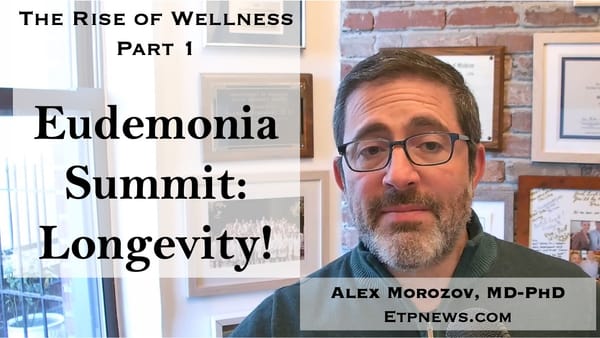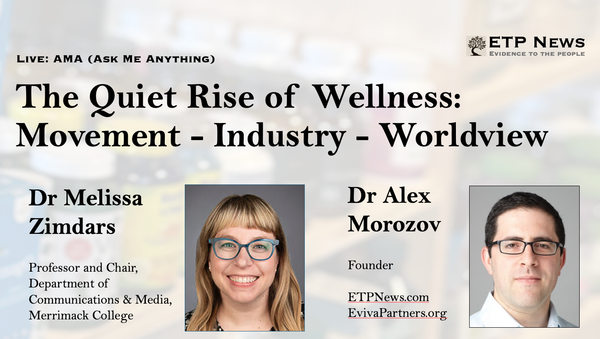Conservative Forces Behind Today’s CDC Demolition Predate Kennedy’s arrival at HHS.
“Never again should public health bureaucrats be allowed to hide information, ignore information, or mislead the public.” - Project 2025.

Today’s news of mass firings at the CDC should not be a surprise. This was predicted almost verbatim in Project 2025.
“Never again should public health bureaucrats be allowed to hide information, ignore information, or mislead the public concerning the efficacy or dangers associated with any recommended health interventions because they believe it may lead to hesitancy on the part of the public,” the document states. It demands to “severely confine the CDC’s ability to make policy recommendations,” and to “investigate, expose, and remediate any instances in which HHS violated people’s rights by colluding with Big Tech to censor dissenting opinions during COVID.”
The “witches brew” of influences guiding Trump’s and Kennedy’s healthcare agenda that we discussed in February is on display.
There is Kennedy’s MAHA and its vaccine skepticism and concerns about medication as cause of disease. There is Lee Zeldin and Brooke Rollins’ America First Policy Institute, concerned with access and drug prices.
And then there is the Heritage Foundation and its Project 2025, which did not mention vaccines as a concern but rather that “thousands of Americans of faith and conscience wish to receive various childhood vaccinations for themselves and their families but are not allowed to receive vaccines that are derived through or tested on aborted fetal cells… There are ethically derived alternatives abroad that have been used safely there for decades, but the FDA makes it exceedingly difficult for Americans to import them.”
These influences are sometimes at odds. The Heritage’s hawkish CEO, Kevin Robbins, paints a vision for the country in his 2024 book, Dawn’s Early Light (with a Foreword by JD Vance): “A bright American tomorrow, one full of children, prosperity, community, growth, faith, virtue and liberty.” “A culture of children is a culture of hope,” he says. “The more children we have, the more young people we will have to help solve problems of tomorrow.”
But there is a real possibility that Kennedy’s MAHA platform could interfere with this vision, instead leading to massive death and suffering in this country and globally: gutting federal healthcare agencies of people and budgets, stopping medical research projects, delegitimizing the medical establishment which has been refining the art and science of medicine for centuries, fear-mongering leading to under-use of evidence-based interventions; by ignoring disparities in care that are the main problem in the US, as AFPI rightfully points out. And finally, by scientific fraud and “manufacture of evidence” which threatens to damage the integrity of scientific literature for generations to come, around the world.
In February, I spoke about this with Ed Fuelner, the founder and long-time CEO of the Heritage Foundation.
“I can say this with some certainty. Until President Trump decided that Robert F. Kennedy Jr would be his nominee for Health and Human Services, we had not had much to do with him,” he told me.
“Mitch McConnell has been a good friend of mine for a very long time – 30-35 years. He is exactly my age. For him to suffer polio the way he did at the very early age, and for somebody else to say the polio vaccine doesn’t work – well, if I were Mitch McConnell I would be pissed off about that too.”
I asked him – “Is there a concern for you or for other folks in the Heritage Foundation that here is a moment in history where there is an opportunity for the New Conservative Movement to finally achieve its agenda. But is there a concern that it could be marred, or stained, as a result of the botched execution by Robert F. Kennedy, Jr.? Telling people to stop taking vaccines, medications, not trusting doctors – people will die.”
“Well, think about how many people are dying already because of obesity, or red dye, or whatever – things that Kennedy has been so outspokenly opposed to,” he replied. “I’m never going to be somebody who anticipates what the media will say. I was at a conference today and I said in conclusion, ‘I’ve been around Washington long enough to know, there are no permanent defeats. But again, there are no permanent victories – just permanent battles. And every battle has to be fought in terms of the principles we believe in.”
“I am used to thinking about evidence,” I responded. “And I worry that at the end of the day it will not be political. Scientists will review all the data and they will add up the outcomes. And I worry that outcomes will become worse as a result of Robert F. Kennedy Jr’s agenda. And I worry that this will put a stain on the conservative movement.”
“I certainly hope not, but you and I will certainly agree that evidence is black-and-white. If it’s black, it’s black. If it’s white, it’s white. You don’t change the evidence to fit your theory. If you are at Sloan-Kettering and the head of the department says, ‘you have a cancerous prostate, we have to take it out’ – you say, ‘Yes Sir, when can we do it?”
I gave him some examples of damage to public health Kennedy could cause.
“You are absolutely right. The vaccines that have gone through appropriate clinical trials – it’s like polio and McConnell.”
The idea of think tanks helping with presidential transitions is not new. Democrats were first, with the Brookings institution going back to 1916. John F. Kennedy, for example, relied on about 100 Brookings scholars for policy issues. On the conservative side, there was a gap. “The left had a finely tuned policy-making machine, and the right had nothing to match it,” recalled Ed Feulner who would go on to become the Founder and President of Heritage Foundation when it was formed in 1973 until his retirement in 2013. The goal was to conduct policy research. “A key moment in this alchemy occurred when Brooking’s experts transmuted the academic’s theoretical plan into an acceptable legislative proposal,” described Lee Edward, Feulner’s biographer.
Over the decades, the Heritage Foundation grew into the largest think tank in the US, with about a 100-million-dollar annual budget, a lobbying arm, hundreds of researchers and hundreds of thousands of paying “members” who represent a “national movement,” in the words of Edward. In addition, Heritage maintains what is known as a “Resource Bank” to “identify conservative policy experts on and off the campus and connect them to the Washington Policy community.”
It’s not just small donors that support the Heritage Foundation. Its donor list is hidden due to its 501(c)3 nonprofit status, but is thought to include industry influences, going back to the original founding grant from Joseph Coors, a beer magnate. Big conservative donors such as Koch and Scaife are behind it as well, as Jane Mayer describes in her book, Dark Money.
In 1981, The Heritage Foundation released a unique document, “unprecedented in national policymaking.” It was called “Mandate for Leadership” and was designed to serve as a guide for the next republican President, at that time Ronald Reagan. Since then, there have been nine editions of the Mandate for Leadership. Project 2025 is the latest one.
Over the decades, through the successive editions of the Mandate for Leadership, the evolving Heritage Foundation ideology is laid bare. In a recent lecture, Dr Brian M. Conley, the Chair of Political Science and Legal Studies at Suffolk University in Boston, describes three factions of the Republican party: Libertarians, with the idea of limited or no state; Traditionalists, promoting family, religious life and moral state; and Corporatists, promoting a free market, corporate power and a “pro-business regulatory state.” “The first, 1981 edition, heavily, disproportionally, almost exclusively, overwhelmingly favors a corporatist perspective,” says Conley. “Its primary function was to combat, counter, capture and remake the regulatory state. It outlined how the Executive Branch could be remade to promote and protect business interests. And this remains unchanged today.”
How to accomplish this? “The whole effort is animated by the Reagan-era maxim that personnel is policy, that power flows from having the right people in the right jobs,” writes Alex MacGillis in Propublica. “Act promptly to fill vacancies and find persons of high quality and friendly persuasion,” quotes Conley from the first edition of Mandate for Leadership. This theme echoes through Project 2025, which includes, in addition to the book, a database of up to 20,000 “potential administration officials” created in a massive, 22-million-dollar effort unprecedented even for the Heritage Foundation itself. “Heritage usually compiles its own personnel lists, and spends far less doing so. But for this election, after conservatives and Mr. Trump himself decried what they viewed as terrible staffing decisions made during his administration, more than 50 conservative groups have temporarily set aside rivalries to team up with Heritage on the project,” reported The New York Times.
It is therefore no surprise that Trump tapped many of key Project 2025 players for key positions in the new administration. This is “personnel is policy” in action.
There is Russel T. Vought, the Head of OMB, is one of the Project 2025 key authors. Jay Bhattacharia has several connections to conservative think tanks, most notably the American Institute for Economic Research (AIER), located in Great Barrington, MA, which sponsored the eponymous Declaration for which Bhattacharia is well-known. William Ruger, the President of AIER, is an author of Project 2025 and spent years working at the Charles Koch Foundation. The Koch family is a major supporter of the Heritage Foundation. And Stanford, where Bhattacharia is on faculty, has a history of associations with conservative think tanks.
Marty Makary is a graduate of the Claremont Institute and a Fellow of the Paragon Institute, both on Project 2025’s Advisory Board. So is America First Legal Foundation, founded by Stephen Miller, Trump’s Deputy Chief of Staff for policy.
You can see in Project 2025 some of talking points later adopted by Kennedy: “As a result of HHS’s having lost its way, U.S. life expectancy, instead of returning to normal after the COVID -19 pandemic, continued to drop precipitously to levels not seen since 1996 with white populations alone losing 7 percent of their expected life span in just one year.”
Traditionalist themes are of course present as expected for any conservative agenda. Anti-abortion, anti-gay marriage, anti-transgender themes run throughout, at times bordering on comical – “homes with non-related “boyfriends” present are among the most dangerous place for a child to be.” But the language has become more extreme. While the 2016 edition of Mandates for Leadership meekly states, “Providers and organizations should not be required to offer services, such as abortion, that violate their conscience,” Project 2025 takes a more aggressive stance, calling for withdrawal of mifepristone from the market, and policing of abortions in blue states by the CDC, among other measures.
In addition to calling for decimation of the CDC, another libertarian theme has emerged in Project 2025 as compared to 2016: anti-elitism. Russel Vought, in his Project 2025 chapter, attacks the “pervasive notion of expert ‘independence’ that protects so-called expert authorities from scrutiny.” Makary and Bhattacharia would agree. Both have come out strongly against the medical establishment. Their colleague on the editorial board of a new anti-establishment journal said, “Traditional medical journals are dead.”
However, the main theme of the Project 2025 document, consistent with the Heritage Foundation ideology, is corporatist, Conley told me. But corporatists have a problem: how to communicate their unpopular pro-business message to the public. “For politics in the US to be successful it has to become ‘Majoritarian’ - it has to appear like it has a broad base of support in the public. That was always a challenge for the business community: ‘how do we create a majoritarian base when we represent a very small percentage of the people?’ And the way to do it is to say, we are not the threat. The government is the threat,” he says in his lecture.
Project 2025 does have prominent anti-corporate themes that are echoed by Bigtree, Senator Ron Johnson, Makary and Bhattacharia, talking of conflicts of interest and mechanisms by which “pharmaceutical companies capture the agencies that regulate them.” But behind the veneer of anti-industry messaging is a pervasive pro-business agenda, such as for example in requiring “efficacy trials of new applications for generic drugs, which might include NIH funding such trials or conducting its own,” a huge win for the pharmaceutical industry. Drug prices, one of the pervasive issues of US healthcare today, is not even mentioned. No wonder the industry has remained quiet.
And while many of us were baffled by Trump’s and Kennedy’s confusing stance towards pharma, it is now clear which industry is squarely behind this administration - and it’s not pharma. It is wellness. We are about to see wellness products starting to be reimbursed by CMS. Stay tuned for more on this.
Overall, Project 2025 has taken a much more extreme, darker, combative stance than the 2016 version. The reason is clear: Following the stepping down of Ed Fuelner as CEO (who remains active on its Board of Trustees), Kevin Roberts took the helm in 2021. His Dawn’s Early Light calls for a “Second American Revolution” - “a crusade to take back our country” - by “The New Conservative Movement” against the “coastal elites,” who are committing “a conspiracy against the American people.”
The decimation of the CDC is another step in the execution of this agenda.




